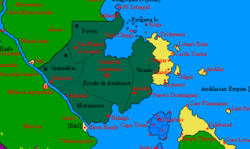Ciudad de Anahuaco

|
This article or section is a work in progress. The information below may be incomplete, outdated, or subject to change. |
| Nation: | Anahuaco |
| Population: | 12 million |
| Predominant language: | Martino |
|
| |
| Main roads: | Avenida Central, Rio Becerra, Minas de Cobre, Paseo Imperial |
| Major districts: | Delegación Centro, Sánchez Taboada, Batáquez, González Ortega,Los Algodones, Colonias Nuevas, Ejido Hermosillo |
|
| |
| Current mayor: | Fernando de la Barrera |

| |
| Map versions: | N/A - |
Ciudad de Anahuaco (Britannic Istvanistani: Anahuaco City) is the capital and largest city in Anahuaco. Famed for its broad streets, classical architecture and stunning mountain scenery, the city is the seat of the imperial government.
With a population of approximately 12 million residents, the city covers an area of 1,524 km2 and is believed to be the largest city on Keltia, in terms of both population and geographical size.
Positioned on a broad, temperate plateau between the two branches of the Sierra del Sur mountain range, Ciudad de Anahuaco's natural beauty, strong economic base and strategic position have all played a role in the city's rich and influential history.
History
In the pre-Aanahuaco era, the city developed as a relatively small but nevertheless significant trading settlement. The area's rich agricultural lands gave rise to a bustling city market, that still exists to this day, serving both the local population and merchants from across southeastern Keltia.
While the city is surrounded on two sides by parallel branches of the Sierra del Sur, the plateau on which the city was built provided a welcome respite for travellers moving across the continent, allowing them to recuperate before tackling the next part of the range. This strategic position propelled the city to prominence early on, and area's population grew steadily as merchants and agricultural workers converged on the settlement.
By the time of the Ciudad Grande agreement, the city was already by far the largest and most prominent in the area, which is why it was chosen as the first capital city of the early inhabitants.
The settlement's growth accelerated rapidly during the waves of migration that followed, and the city's role as capital made it famous throughout the region. However, not all of the attention the city received was positive, as evidenced by the siege of 1704, which saw brands of armed emigres surround and capture the capital. The city was surrendered to the uprising on June 17th 1704, to avoid bloodshed and damage to local homes and infrastructure.
The city played host to the early negotiations on the formation of a new nation, and was the location of the declaration of el Imperio Anahuacano in 1705.
It was at this time that the city ceased to be known as Ciudad Grande, and took on the name Ciudad de Anahuaco. The capital's place in the new nation was cemented with the arrival of José Joaquín Garcia March 21st 1706. With the Emperor enthroned in the city's cathedral on the same day, Ciudad de Ananhuaco is rightly considered the birthplace of the empire.
In the years that followed the city was developed as a true imperial capital, with wide boulevards, tree-lined squares, vast public parks, fountains, palaces, and all the other trappings of a classical empire. While city planners created the heart of what is now the old city, the empire's creation had an even bigger, and unintended, consequence for Ciudad de Anahuaco.
The political stability in the area, technological advancements and openness to the outside world all made the city an ever-more attractive place to live and work. For that reason, as the old city took shape, sprawling new towns cropped up to house the city's spiralling population. With more pressing matters to attend to elsewhere in the country, the federal government devoted very little attention to this issue, and as the result the city grew into a vast, largely unplanned settlement.
While a rolling program of city integration continues, including linking up new districts to roads, mains water, electricity and other services, a large part of the city's population lives in what are essentially informal housing areas.